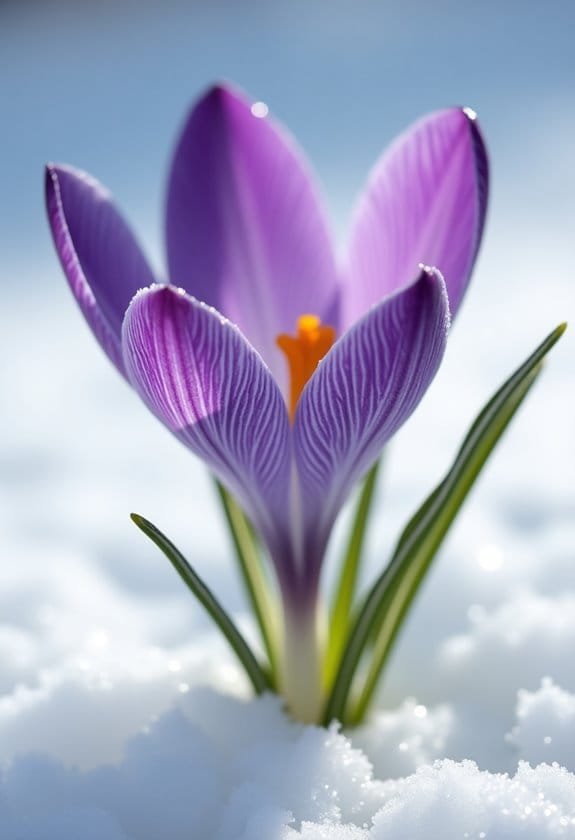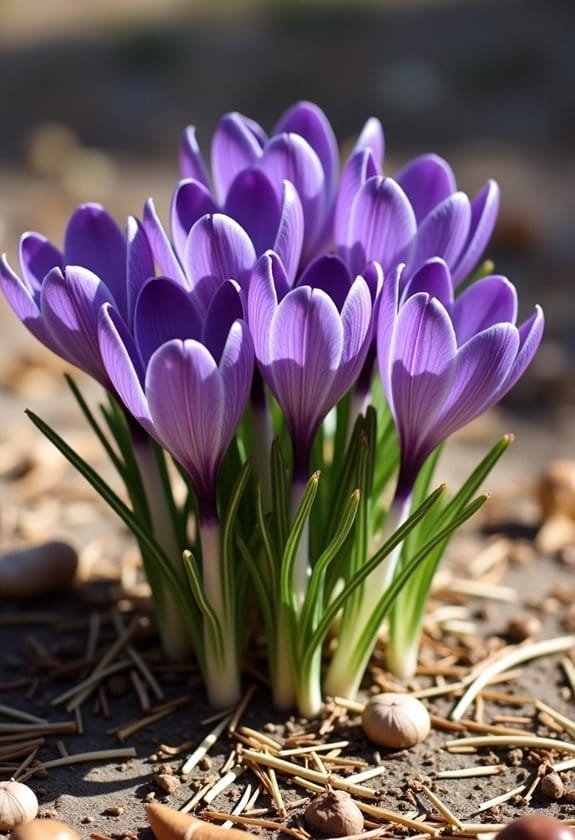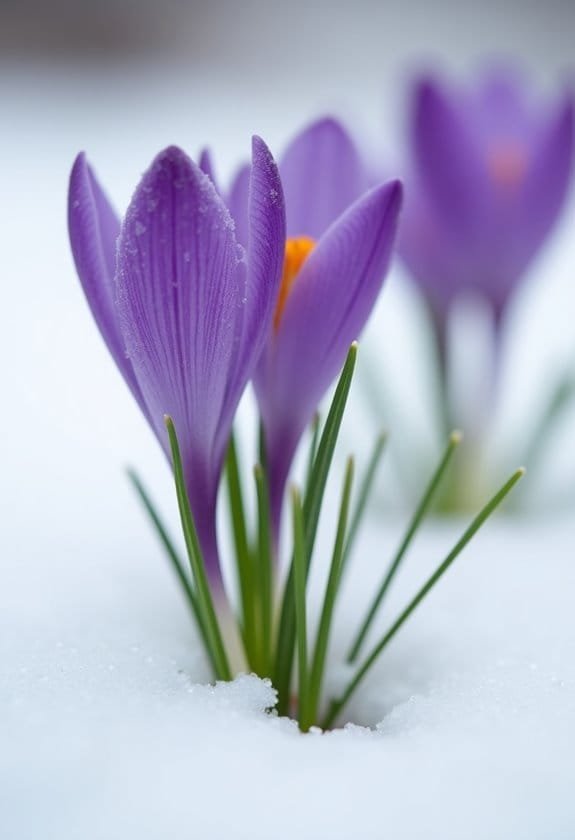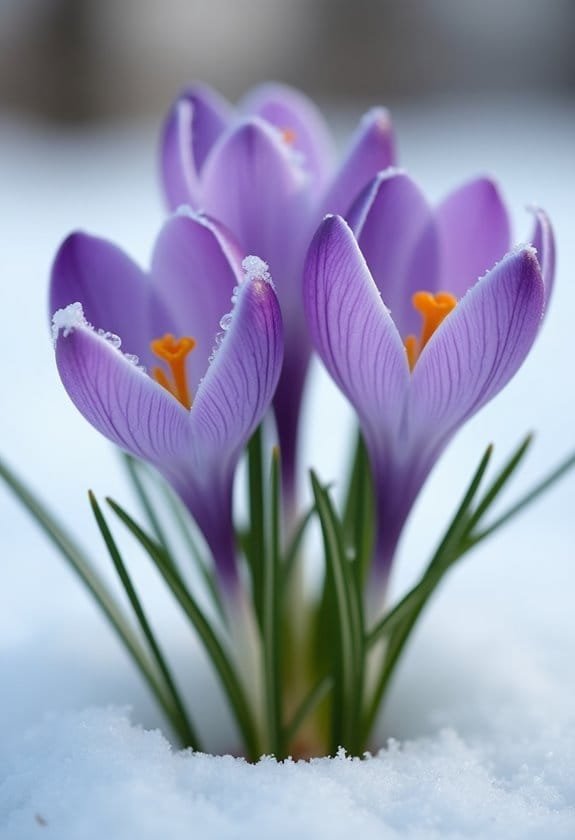Crocus species are early-spring flowering plants belonging to the Iridaceae family, with approximately 100 species found primarily across Europe, North Africa, and Asia. These resilient perennials showcase distinctive cup-shaped blooms in vibrant whites, yellows, purples, and oranges, emerging through late winter's frost. Among them, Crocus sativus stands out as the source of prized saffron spice. The plants feature unique linear, bifacial leaves and thrive in well-draining soil when planted 3-4 inches deep. They're essential early-season food sources for pollinators, particularly bees and butterflies emerging from winter dormancy. Understanding these remarkable plants reveals nature's intricate balance between beauty and ecological significance.
Main Points
- Crocus belongs to the Iridaceae family with approximately 100 species found primarily in Europe, North Africa, and Asia.
- Crocus flowers feature distinctive cup-shaped blooms in white, yellow, purple, and orange with linear, bifacial leaves.
- Crocus sativus is the most commercially significant species, providing the valuable spice saffron from its flower stigmas.
- Most species bloom in early spring, while some varieties like Crocus sativus flower in autumn.
- Crocus plants require well-draining soil, 3-4 inch planting depth, and serve as crucial early-season food sources for pollinators.
Introduction

Crocus species, comprising approximately 100 members of the Iridaceae family, represent some of nature's earliest spring bloomers across Europe, North Africa, and Asia.
The genus, scientifically classified as Crocus L., includes both wild and cultivated varieties that produce distinctive cup-shaped flowers in vibrant shades of purple, yellow, white, and orange.
These resilient perennials emerge from underground storage structures called corms, with some species, especially Crocus sativus, holding particular significance as the source of the precious spice saffron.
Common Name
Throughout history, the name "crocus" has carried deep cultural significance, deriving from the Greek word for saffron. This ancient etymology reflects the plant's enduring connection to human civilization, particularly through the renowned saffron crocus (Crocus sativus), which has been prized for millennia for its valuable spice production.
Common names for various crocus species often reflect their distinctive blooming patterns or physical characteristics. The snow crocus, for instance, earned its moniker due to its remarkable ability to push through late winter snow, heralding the arrival of spring with its delicate petals.
Gardeners and botanists frequently use these descriptive common names alongside scientific classifications to distinguish between the genus's 80-plus species.
These vernacular names vary across different cultures and regions, with local traditions often influencing how people refer to these beloved flowers. While some varieties carry straightforward descriptors based on their colors or blooming seasons, others possess more poetic names that capture their cultural significance, such as "autumn crocus" or "meadow crocus," reflecting their natural habitats and flowering periods.
Scientific Name
Diving into botanical nomenclature, the genus Crocus belongs to the family Iridaceae and encompasses approximately 100 species of perennial flowering plants. The scientific name derives from the Greek word "krokos," which directly references these plants' historical significance as the source of saffron.
The taxonomic classification of Crocus flowers has evolved through extensive research, with molecular phylogeny helping scientists understand the relationships between various species and subspecies. These perennials growing from corms are systematically organized into distinct sections, reflecting their evolutionary history and morphological characteristics.
Among the most remarkable species is Crocus sativus, the source of saffron, which exemplifies the genus's taxonomic complexity and economic importance. The species' distribution spans three continents, with over 80 recognized species mainly found across Europe, North Africa, and Asia.
This geographical diversity has contributed to the development of numerous subspecies and varieties, each adapted to specific environmental conditions. Modern botanical studies continue to refine our understanding of Crocus classification, particularly through DNA analysis and comparative morphology.
Overview
When you spot the first blooms of spring peeking through late winter's snow, there's a good chance you're witnessing the emergence of crocuses. These remarkable species of perennials, belonging to the Iridaceae family, comprise approximately 100 distinct flowering plants that herald the arrival of warmer days.
Native to regions spanning Europe, North Africa, and Asia, crocuses have established themselves as quintessential garden favorites due to their extraordinary resilience and vibrant displays.
These low-growing plants emerge from specialized underground storage structures called corms, producing striking blooms in shades of white, yellow, orange, and purple. Their ability to naturalize in gardens, particularly evident in hardy varieties like Crocus chrysanthus and Crocus tommasinianus, makes them invaluable additions to ornamental landscapes.
The flowering sequence typically begins as early as January, reaching its magnificent peak in February when many other plants remain dormant. Following their spectacular display, crocuses enter a period of dormancy, during which they store energy for the next season's growth, demonstrating the remarkable efficiency of their survival strategy.
Key Features
Crocus species showcase a compact growth habit, typically reaching heights of 3-6 inches (7.5-15 cm) with slender, grass-like foliage emerging directly from underground corms.
The distinctive flowers feature six-lobed blooms arranged in a star pattern, complemented by prominent stamens and supported by a long, protective floral tube that extends deep into the soil.
These resilient plants display remarkable seasonal diversity, with different species blooming from late winter through autumn, though most varieties produce their vibrant displays in early spring when few other garden plants are flowering.
Growth Size
Though small in stature, different crocus species vary considerably in their growth dimensions. Early snow crocuses maintain a diminutive profile, typically reaching just 1-2 inches in width and standing less than 3 inches tall, making them perfect for intimate garden spaces and naturalized meadow settings. These resilient perennials create a delicate carpet of blooms while growing close to the ground.
In contrast, giant crocuses command more attention in the landscape, stretching upward to 6 inches in height and spreading 3-4 inches wide. Their larger presence makes them particularly striking when planted in deliberate patterns or drifts.
Regardless of size, all crocuses benefit from proper spacing of 3-4 inches between bulbs, allowing their root systems to develop without competition. This careful placement guarantees ideal growing conditions and prevents overcrowding as the plants mature.
The compact nature of these hardy flowers makes them remarkably versatile, thriving in various soil conditions from sandy to loamy textures, provided adequate drainage exists. Their adaptability to different garden settings, combined with their range of sizes, offers gardeners flexibility in design while maintaining the characteristic low-growing charm of the species.
Appearance
The distinctive features of crocuses encompass both their vibrant blooms and unique foliage structure. These species of perennials display a remarkable spectrum of colors, from pristine whites and sunny yellows to deep purples and vivid oranges, creating a tapestry of hues in early spring gardens.
The flowers emerge from a sophisticated arrangement of linear, bifacial leaves that showcase an elegant boat-shaped cross-section, supported by protective membranous cataphylls at their base. Each bloom presents a complex structure with a long, cylindrical floral tube that opens into six graceful lobes, arranged in two distinct whorls like a perfectly balanced architectural design.
Within these delicate blooms, three stamens stand ready to release their precious pollen grains.
What makes these early bloomers particularly significant is their wide range of flowering times, with some varieties breaking through winter's grip as early as January. Their blossoms, varying from the modest 1-2 inch snow crocus to the more commanding 3-4 inch giant varieties, serve as nature's heralds of spring, brightening landscapes while most other plants remain dormant.
Flowering Season
Throughout the growing season, diverse crocus species create a stunning display that begins in late winter and extends into autumn. Among these resilient bulbs and perennials, wild varieties emerge as early as January, breaking through winter's last frost to herald spring's approach. The remarkable snow crocus leads this procession, often pushing through February's cold ground with its delicate blooms.
Dutch crocuses follow closely behind, enriching gardens with their vibrant spectrum of colors and distinctive striped patterns during the early spring months. The flowering duration of most crocus species typically spans between two and five weeks, though environmental factors such as temperature and moisture levels can influence this timeframe.
While spring-blooming varieties dominate the genus, some species, particularly the celebrated saffron crocus, reserve their blossoms for the autumn months, providing gardeners with an unexpected burst of color when most other plants are preparing for dormancy.
This extended blooming sequence, from winter through fall, makes crocus species particularly valuable for maintaining continuous garden interest throughout multiple seasons.
Growing Requirements

Crocus species flourish in environments that provide full sun to partial shade, where they can harness ideal light energy for photosynthesis.
These resilient plants demand well-draining soil conditions, whether sandy or loamy, and should be planted at a precise depth of 3-4 inches during the autumn months.
Their adaptability to temperature fluctuations makes them particularly hardy in late-winter conditions, though they benefit from consistent moisture during their establishment phase and occasional fertilization with balanced nutrients in early spring.
Light
While many flowering plants struggle in winter's waning light, most crocus species thrive in full sun to partial shade conditions. These resilient bloomers have adapted to maximize their exposure to available sunlight during the shifting seasons, which directly enhances their blooming potential and overall vigor.
The positioning of crocus plantings plays a vital role in their light requirements, with early snow varieties particularly benefiting from strategic placement in sunny, protected areas. When planted in clusters along south-facing slopes or in locations that receive ample morning sun, these hardy perennials can produce more abundant and vibrant displays.
The plants' ability to photosynthesize efficiently, even in cooler temperatures, allows them to generate energy for spectacular blooms while other garden species remain dormant.
Interestingly, different crocus varieties have evolved to respond to varying light conditions throughout their blooming seasons, from late winter through early spring and even autumn. This adaptation enables them to capture ideal light levels during their specific flowering periods, whether they're early snow crocuses breaking through February's frost or fall-blooming varieties catching the last warm rays of autumn.
Soil
Healthy soil provides the foundation for thriving crocus plants, with well-drained conditions being absolutely essential for their survival. Crocus species require soil that efficiently channels excess moisture away from their bulbs, as poor drainage can lead to devastating root rot and bulb deterioration. The ideal soil pH for these resilient bloomers falls between 6.0 and 7.0, creating an environment where nutrients remain readily available for absorption.
While these adaptable plants demonstrate remarkable versatility in their soil preferences, they flourish most impressively in moderately fertile conditions that mirror their natural habitat.
Gardeners can enhance growing conditions by incorporating crushed stone mulch into raised beds, which perfectly simulates the winter-wet, summer-dry environments where these plants naturally evolved. The strategic application of mulch serves a dual purpose: it maintains consistent soil moisture levels while simultaneously suppressing unwanted weed growth that might compete with the crocus bulbs.
Sandy and loamy soils prove particularly suitable for crocus cultivation, though careful soil preparation can help these determined plants succeed in various ground conditions, provided proper drainage remains the priority.
Water
Three fundamental principles guide proper watering for crocus species: moderation, timing, and drainage awareness. These resilient plants have evolved to thrive with minimal water intervention once they've established their root systems, making them particularly suitable for low-maintenance gardens.
Water management begins at planting time, when thorough irrigation helps bulbs establish strong root networks before winter dormancy sets in. During the growing season, moisture requirements remain modest, though careful attention must be paid during dry spells, particularly when plants are actively developing their foliage and flowers.
The key lies in maintaining consistent but not excessive moisture levels.
To enhance water retention while preventing oversaturation, applying a layer of mulch around crocus plantings serves multiple purposes. This protective barrier helps maintain soil moisture at ideal levels while simultaneously suppressing competing weeds that might otherwise steal valuable water resources.
After blooming, it's essential to maintain moderate soil moisture until the foliage naturally withers, as this process enables the bulbs to absorb essential nutrients and store energy for next season's growth cycle.
Temperature
According to their Mediterranean origins, crocus species demonstrate remarkable adaptability to temperature fluctuations, thriving in climates with winter-wet and summer-dry conditions.
These resilient plants have evolved to withstand late-winter chills and early spring frosts, often emerging as nature's first heralds of warmer days ahead.
The ideal growing temperatures for crocus species typically range from 55°F to 65°F (13°C to 18°C) during their active growth phase, though they're capable of enduring considerably colder conditions.
Their ability to flourish in well-drained soil plays an important role in their temperature tolerance, as proper drainage helps prevent bulb damage during freeze-thaw cycles. This adaptation allows them to survive in various soil compositions, from sandy to loamy textures.
For successful cultivation, gardeners should plant crocus bulbs in autumn, allowing sufficient time for root establishment before winter's arrival.
This timing is essential as it enables the plants to develop cold hardiness and prepare for spring emergence, when soil temperatures begin to rise and trigger their growth cycle.
Pollinator Criteria
Crocus species serve as crucial early-season food sources for emerging pollinators, particularly bees and butterflies seeking nectar after winter dormancy.
Their vibrant, cup-shaped blooms produce high-sugar nectar that proves especially attractive to these essential insects during a time when few other flowers are available.
The strategic timing of crocus blooming, often occurring before tree canopies develop their full foliage, guarantees maximum visibility to pollinators while providing them with critical sustenance during the changing period between winter and spring.
Attracted Pollinators
Emerging as early spring pioneers, these vibrant flowers serve as vital food sources for various pollinators. Crocus flowers have evolved a specialized relationship with early-season insects, particularly bees and butterflies emerging from winter dormancy. Their distinctive cup-shaped blooms, adorned in shades ranging from brilliant yellows to deep purples, act as natural beacons for these significant pollinating species.
The strategic blooming period of crocus species perfectly aligns with the seasonal emergence of pollinating insects, creating an intricate ecological synchronization. These flowers have developed abundant pollen production capabilities, guaranteeing sufficient nutritional resources for insects during a time when other food sources remain scarce.
The accessibility of their open flower structure allows even weaker spring pollinators to navigate the blooms efficiently, while their vibrant petals serve as natural landing platforms. Through their evolutionary adaptations, crocus species have become fundamental players in supporting early-season pollinator populations, offering both nectar and pollen rewards to their visitors.
This mutually beneficial relationship guarantees successful reproduction for the flowers while providing vital sustenance for insects awakening from their winter respite.
Pollination Method
Nature's pollination choreography in Crocus species relies on precise criteria that have evolved over millennia. The process centers on the actinomorphic flower structure, which provides an ideal landing platform for visiting insects, particularly bees seeking nectar rewards.
These symmetrical blooms have developed specialized features that facilitate efficient pollen transfer while ensuring cross-pollination among different plants. The success of Crocus flowers' reproductive strategy depends on their abundant pollen production and strategic timing of bloom periods.
When early spring arrives, these flowers synchronize their emergence with the activity patterns of their primary pollinators, creating an intricate ecological dance. The vibrant petals serve as beacons, attracting insects through both visual signals and nectar incentives, while the flower's architecture guides visitors toward reproductive structures.
As pollinators move between flowers, they inadvertently collect and deposit pollen grains, promoting genetic diversity within Crocus populations. This sophisticated system demonstrates how these plants have adapted their reproductive mechanisms to maximize pollination efficiency, ensuring their continued survival across diverse environmental conditions.
Care & Maintenance

Successful crocus cultivation begins with proper fall planting, where bulbs need a precise depth of 3-4 inches in well-draining soil and adequate spacing to create stunning natural displays.
Once established, these resilient bloomers require minimal intervention, though they benefit from early spring fertilization and consistent moisture monitoring during their active growth phase.
The maintenance routine includes deadheading spent flowers and allowing foliage to naturally wither, which guarantees the bulbs store sufficient energy for subsequent growing seasons while creating space for compatible companion plants like daffodils or grape hyacinths.
Planting Tips
When autumn arrives, planting crocus bulbs requires careful attention to depth and spacing for ideal growth. Gardeners should position these charming harbingers of spring approximately 3-4 inches deep in well-drained soil, maintaining similar spacing between bulbs to create stunning natural-looking clusters.
The selection of an appropriate planting location proves essential for these diminutive beauties, as they flourish in areas receiving full sun to partial shade. After nestling the bulbs into their new home, a thorough watering helps establish strong root systems before winter's arrival.
When spring emerges, applying a balanced bulb fertilizer guarantees robust growth and abundant blooming.
Post-flowering maintenance plays a significant role in preserving bulb health. Gardeners should deadhead spent blooms promptly, allowing the plant to redirect energy toward bulb development rather than seed production.
The foliage must be left intact until it naturally withers, as this process enables the bulbs to store nutrients for next season's display. While monitoring the garden, keep watch for unwanted visitors like slugs, which can damage emerging shoots and flowers.
Ongoing Care
Proper care and maintenance of crocus bulbs throughout their growing cycle guarantees years of vibrant spring displays.
During dry spells, especially in the early growth stages, consistent watering proves fundamental for developing robust root systems and guaranteeing spectacular blooms. The application of a balanced bulb fertilizer in early spring provides these diminutive beauties with the essential nutrients they need to thrive.
After the flowers have completed their show-stopping performance, it's important to deadhead spent blooms, allowing the plant to redirect its energy into bulb development rather than seed production.
The foliage should be left intact until it naturally yellows and withers, as these leaves act as solar panels, collecting and storing energy for next season's display. While the leaves may appear untidy, this post-bloom period is significant for the bulb's survival and future flowering potential.
Regular monitoring for signs of pest infestations or disease guarantees early intervention when necessary, protecting these delicate harbingers of spring from potential threats that could compromise their health and vigor.
Suggested Companions
Harmonious plant combinations enhance the beauty of crocus displays while maximizing garden space and functionality. When planning companion plantings, crocus species benefit considerably from partnerships with early-blooming bulbs like snowdrops and winter aconites, which create a stunning tapestry of seasonal color in the garden's awakening moments.
For sustained visual interest, low-growing perennials such as heucheras and sedums provide excellent companionship, as their foliage complements the crocus blooms without overwhelming them.
The integration of taller spring bulbs, particularly daffodils and tulips, creates an engaging vertical dimension that unfolds in a carefully orchestrated sequence of blooms throughout the season.
Drought-tolerant companions, including lavender and thyme, prove especially valuable as they share similar cultural requirements and help maintain ideal soil conditions for crocus growth.
Ground-hugging plants like creeping thyme and moss phlox serve multiple functions, forming a living mulch that suppresses weed growth while creating a cohesive backdrop for emerging crocus blooms.
This thoughtful combination of plants guarantees year-round interest while supporting the specific needs of these beloved spring bloomers.
Common Issues
Crocus species face several significant challenges from both pests and diseases, with slugs and cutworms posing particular threats to their delicate foliage and blooms.
Root and bulb rot can devastate these plants when they're subjected to poor drainage conditions or excessive watering during their growing cycle.
Gardeners can protect their Crocus plantings by maintaining proper soil drainage, spacing bulbs appropriately at 3-4 inches apart, and allowing foliage to naturally die back after flowering seasons.
Pests/Diseases
Gardeners must remain vigilant against several common pests and diseases that threaten crocus plants. Among these adversaries, slugs pose a significant threat to young foliage and flowers, methodically consuming tender growth and potentially decimating new plantings.
Fortunately, targeted treatments like Sluggo can effectively control slug populations without compromising beneficial garden organisms.
Bulb flies represent another formidable challenge, as these persistent pests burrow into crocus corms, initiating a destructive cycle of decay that can devastate entire plantings if left unchecked. Their presence often goes unnoticed until plant health begins to decline, making regular inspection essential for early detection and management.
Fungal diseases, particularly botrytis blight, emerge as significant concerns during periods of excessive moisture. When drainage is inadequate, this pathogen manifests as unsightly leaf spots and flower deterioration, potentially undermining the plant's vigor.
To maintain healthy crocus specimens, gardeners should guarantee proper soil drainage and maintain appropriate spacing between plants, allowing adequate air circulation. Early recognition of symptoms, combined with swift intervention, typically yields the best outcomes in managing these common afflictions.
Solutions
While addressing pest and disease challenges requires vigilance, most common issues affecting crocus plants have straightforward solutions. For ideal growth, gardeners should focus on proper planting techniques, positioning corms at 3-4 inches deep with equivalent spacing to prevent overcrowding and subsequent blooming issues.
Pest management becomes markedly easier when implementing targeted solutions, such as applying Sluggo to control persistent slug and cutworm populations that might damage emerging shoots.
Fortunately, local squirrels typically avoid consuming crocus corms, which naturally reduces the need for additional rodent deterrents in most garden settings.
The key to maintaining healthy Crocus species lies in providing well-drained soil conditions, as these resilient plants thrive with minimal intervention when properly situated.
Regular maintenance practices, particularly deadheading spent blooms, play a vital role in preserving the plant's energy reserves and preventing potential disease development.
This systematic approach to care, combined with proper spacing and drainage considerations, creates an environment where these adaptable plants can flourish with relatively little ongoing maintenance requirements.
Summary

Throughout many regions of Europe, North Africa, and Asia, the vibrant and resilient genus Crocus has established itself as a cherished early-blooming flower. These remarkable perennials, comprising approximately 100 species, have adapted to diverse climates and continue to captivate gardeners with their stunning displays of yellow, white, and lavender blooms.
The adaptability of Crocus species is evident in their specialized morphology, featuring corms that develop fibrous roots and linear leaves, enabling them to thrive in various garden settings. Popular varieties like Crocus tommasinianus and Crocus sieberi have proven particularly successful for naturalizing, while the prized Saffron Crocus stands out for its culinary and medicinal applications.
These hardy plants require minimal maintenance once established, typically flourishing when planted at depths of 3-4 inches in well-draining soil during autumn months. Their early blooming period, sometimes beginning as early as January, makes them invaluable additions to winter gardens, providing essential color and life when most other plants remain dormant.
The genus's continued popularity among gardeners worldwide testifies to its enduring appeal and practical versatility in landscape design.


